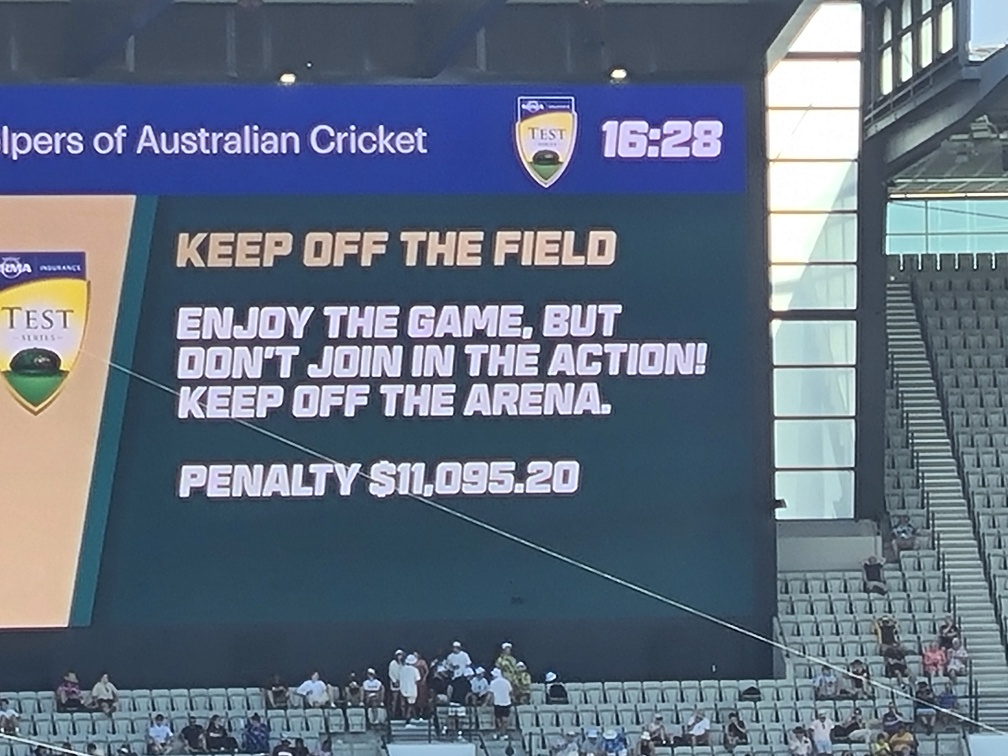Learn English while learning about daily life in Australia, with Rob McCormack
Podcast Number 145 – A Day at the Cricket – The Boxing Day Test
(This podcast is 15 minutes and 22 seconds long.)
Hi,
When you think of sport in an Australian summer, you think of cricket. In Podcast 40 (Podcast 40), I talk about cricket in Australia. Every summer we have a series of test matches played all around Australia by the Australian national men’s cricket team. It will be against one, or sometimes two, of our main rivals in international cricket, such as England, South Africa, India, Pakistan, New Zealand, the West Indies or Sri Lanka. Usually there are 5 or 6 tests played, one at each of the major state capital cities in Australia. Each test match can last up to 5 days. The most important of these, in the opinion of many people, is called the Boxing Day Test. It always starts on Boxing Day, the 26th of December, in Melbourne. It is played at the Melbourne Cricket Ground (MCG). For many Australians, it is a traditional Boxing Day activity to watch some of this game on television, or if you live in Melbourne, to attend at least some of this test match. In this podcast, I would like to tell you a little about the Boxing Day test and what it’s like to attend.
As a young person living in Perth, Western Australia in my earlier days, I had always watched the television broadcast of the first day of the Melbourne Boxing Day test. It was like a Boxing Day ritual. Subsequently, I and my family moved to Melbourne in the mid 1990’s. Back then, our two young boys were enthusiastic cricket players, so it seemed to us that attending the Boxing Day test was something not to be missed. It was something we looked forward to every year. Of course, our two boys have since grown up and made lives of their own. In 2022 however, we decided once more to go to the test cricket on Boxing Day here in Melbourne. Our oldest son was visiting us from the USA where he now lives. He was bringing his fiancé, an American, to visit us and he wanted her to experience the Aussie tradition of attending the first day of the Boxing Day Test at the MCG. The match was between Australia and South Africa. Our youngest son joined us as well, so our family was once more attending the test cricket on Boxing Day.
On Boxing Day we drove to a city carpark not far from the MCG, then walked for about 15 minutes to get to our entry gate. When we entered the MCG, we had to show our bags, have their contents inspected and we were also scanned with metal detectors. It was a very efficient process and we were soon heading towards our seats, which we found without problem. The ground appeared to be around 60% full, or around 60,000 spectators by my estimate.
The large top-deck seating areas in the grandstands opposite our seats were mostly empty. Notwithstanding that, there was a real buzz around the ground. It was the first day of the Boxing Day Test and you could feel the excitement from the crowd. Our seats were close to the bars and kiosks where people can buy beer and food, so there was fairly constant movement of people to and from their seats and lots of chatter.
I need to say something about watching test match cricket, because it is a little different to watching many other sports, in my opinion. The pace of the game can be very slow. Many people would say it’s boring. Any game which takes 5 days to play cannot be 100% excitement and action all the time. In a test match, each team will normally have 2 innings of batting, during which all 11 players in each team can bat. The game is won when one team scores more than the total score of the other team over 2 innings. In other words, to win a test, you must bowl out 10 batsmen in the other team, twice. That’s 2 innings and 20 wickets. Because the game can take 5 days, the batsmen have plenty of time. There’s no rush. If the bowler bowls a ball at him which is not quite in the right spot to hit, he may let it go, as long as it won’t hit his wicket. Alternatively, he may just block the ball, with no intention of taking a run. These balls are called dot balls, because the person recording the score just puts a dot in the score book, meaning no run was scored. Batsmen tend to build their innings slowly, choosing the right ball to hit and letting the others go through to the keeper behind him. This is done to avoid the risk of losing your wicket (i.e. getting out). However, even though the pace of the game can be slow, there is always expectation as the bowler runs in to bowl. The batsman plays at the ball, or leaves it, gets a run or doesn’t, then the action stops while the ball is returned to the bowler for his next bowl. Learning how to appreciate test cricket is something which comes slowly and I can understand that some people just find it too slow and boring. But if you are patient, things will happen. The tension builds slowly in test cricket, however batsmen will get runs. Batsmen will lose their wicket. That is the time when the crowd comes alive and cheers. This is especially true when a wicket falls. We all watch the replay on the big screens and enjoy the moment all over again. During the quiet times in the game, mostly the crowd will relax and talk with their companions.
A lunch break of 40 minutes happens at 1.00pm. We decided it was a little too noisy and busy where we were sitting. Instead, we moved to the top level of the grandstand where there were many, many empty seats. There it was much quieter and the view was wonderful from such a high position. Though the players are further away, you can more easily see the play overall and it’s easier to have conversation within your group and enjoy each other’s company, as well as the cricket.
Sometimes the behaviour of the crowd is just as much fun to watch as the cricket. The crowd wave is a favourite pastime at the Boxing Day test. It will be started by a small group of vocal spectators in the lower level. They count down from 10 to 1 then throw their arms up in the air, trying to encourage the spectators in the next section to copy them. Sometimes they do it many times before the wave starts. When it gets going, a wave can be great to watch as thousands of arms are thrown in the air like a wave, rolling around the stadium.
Drinking beer is also a favourite pastime of many in the crowd. Usually, one person from each group of friends will be tasked with getting the beers for the group. They go to the bar and buy several beers which are in plastic cups. The cups are put in a cardboard holder which is used to bring the beers back to the group. When the beers are finished, another person has his turn to get the beers. I can imagine that some spectators would spend a large amount of money on beer at the Boxing Day test. Sometimes, a spectator drinks too much beer and decides to run onto the ground. This stops play while the police or security officers chase after them, grab them and take them away. The crowd always cheers loudly when they are caught. The fine for going onto the ground like this is $11,095.20. I can’t imagine why anyone would do it. Even so, I think there was one on the day we went to the test. For these people, it’s a very expensive day.
We enjoyed our day at the cricket. South Africa was the first to bat and the Australians bowled really well on that first day. They managed to get all of the South African batsmen out, for a low total of 189 runs in 68 overs (that’s 408 balls bowled) before the end of the day’s play. The best Australian bowler was Cameron Green, who took 5 wickets. The Australians were very happy with this result. The Australians started their first innings in the last 2 hours of play and we got the chance to see the first two Australian batsmen. When day one finished at around 6 pm, Australia had not yet lost any of their wickets. Although we didn’t attend any of the following days, Australia went on to score 575 in their first innings over the next 2 days play, including a double century (200) by David Warner and 111 by Alex Carey, both wonderful batting performances. South Africa made only 204 in their second innings, for a total of 393, so Australia won the test match without having to bat in a second innings, winning by 182 runs.
I think our day at the Boxing Day test was a great success. My son’s American fiancé seemed to enjoy the day. I was impressed that she was happy to stay the whole day. I think she is well on the way to understanding what test cricket is all about.
If you have a question or comment to make, please leave it in the comments box at the bottom of this page. Or, you can send me an email at rob@slowenglish.info. I would love to hear from you. Tell me where you live, a little bit about yourself and what you think of my Slow English podcast. I will write back to you, in English of course. If you would like to take a short quiz to see if you have understood this podcast, you will also find it on my website. Goodbye until next time.
Rob
Podcast 145 Quiz - Did you understand the podcast?
You can take the quiz as many times as you like.
Vocabulary
action = the things that are happening
activity = the things people do
alternatively = another way to do something
appreciate = when you understand that something is good
attend = to go to
attend = to go to
avoid = not to do something
bars = a place where you buy alcohol
behaviour = what people and animals do
block = (here) when a batsmen just stops the ball, rather than hitting it away
boring = when an activity is not interesting
bowler = the person who bowls the ball at the batsman
broadcast = when radio and television stations make and send out a program for people
buzz = the sound of the crowd
cardboard holder = a small box used to hold something, made from hard paper
century = 100
chatter = the sound of people talking
cheers = when the spectators yell
companions = your friends who are with you
company = (here) the feeling of being with your friends
constant = never stops, keeps on
contents inspected = when someone looks closely at what is in your bag
copy = do the same
decides = to make a decision
efficient = works quickly and well
encourage = when you tell or show someone they should do something
enthusiastic = done with joy
estimate = to guess how many there are
expectation = what you expect to happen
expensive = costs a lot
experience = to do something, so you know what it is like
fiancé = the person you are going to marry
fine = (here) when you must pay a large amount as punishment
grab = to hold on to someone
grandstands = the place where you sit in a stadium
imagine = when you think of something in your mind
impressed = when you think something or someone is very good
intention = what you want to do
keeper = the player behind the batter who catches the ball
kiosks = a small shop
last = (here) how long something takes
level = how high or low something is
major state capital cities = Melbourne, Sydney, Brisbane, Perth, Adelaide, Hobart
managed = were able to
metal detectors = machines which can find metal on your body
national = at the level of the nation
opinion = what you think about something but you may not be able to prove it
pace = the speed at which something happens
pastime = something people do for pleasure when they are not working
patient = to wait without getting angry
performances = when you do something which needs a high level of skill
relax = when you are not excited
replay = (here) to see a video of what happened
risk = the chance that something might happen
ritual = a process or activity done in a certain way, often for religious reasons
rivals = people or teams you play against
rush = to do something quickly
scanned = (here) using a machine to see through your body
score = how many points or runs you have
score book = the book where the score is recorded
section = a part
security = (here) people whose job it is to keep people or buildings safe
series = a number of events, one after another
spectators = people who watch a game
stadium = grandstand, the place where the spectators sit
subsequently = after, later
tasked = asked to do something
tend = is likely to be
tension = the excitement
traditional = has been done or used for a long time
wicket falls = to get out, to lose your wicket
wickets = the wooden sticks behind the batsman, also when someone gets out (a wicket)




